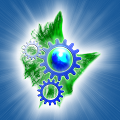Internal Lab
Safety Regulations Lab
Safety Regulations Laser
Safety Instructions Laser
Safety Instructions
It is recommendable to read the following text in full (in German):
http://regelwerk.unfallkassen.de/regelwerk/data/regelwerk/m_uvv/V_B2.pdf
Laser Categories
Category 1:
definitely unperilous
Category 2:
this applies only for VIS-range (400-700nm) not dangerous, if the reflex
of lid closing is working normally (t=0,25s) maximum of 1mW
Category 3 a)
harmful when focusing the laser directly on the eye not dangerous,
if the reflex of lid closing is working normally (t=0,25s) exception: in
non-visible light no harm for the human body
Category 3 b)
harmful for your eyes and skin exception: diffuse reflexes are not
damaging <10s distance >13cm danger of conflagration and explosion
Category 4
in the exposition stage: be always prepared for possible health damages,
i.e. go and see a doctor when already burnt danger of conflagration and
explosion
Laser Scope
While using the laser machine, the laser scope is that area around the
laser in which the boundary value is beyond what is generally regarded
as unperilous. That is why it should be labeled "laser activity area".
Examples: laser frame, above the optical table, parts of the lab. Try to
keep this scope as minimal as possible. The unprotected eye must never
be exposed to this scope!
Laser at Work - Precautions
1. Scope minimization principle:
-
from simple screening oneself up to complete body protection measures
-
keep the course of the laser ray as short and compact as possible
-
optical equipment should be fastened carefully
-
at the point of impingement of the beam make sure it will not cause any
harm (absorption, diffuse reflection)
-
to have the laser beam above or underneath the eyes would best answer the
safety purpose for the eyes
-
no optical axis in direction to the window
-
furniture of the room, windows, floors should reflect the laser beam diffusely
-
same goes for clothing, watches, tools etc.
-
for example, use black lacquer spray for blackening
-
if several work places are in use, screen one from the other
-
additional devices change laser beaming-safety labels are necessary
2. Mode of operation:
-
basic adjustment to laser category 3 a)
-
trimming of the laser beam only in wave-lengths for which there are protection
glasses - if not possible, do it from a safe distance only (cameras, remote
control)
-
screening: try to avoid a direct or diffuse reflex that might hit people
(do not forget warning signs!)
-
before turning on laser category 3 b) and 4, inform people around you about
it
-
even when already wearing protection glasses: do not look into the laser
ray
-
use only that kind of protection glasses that have been produced for the
protection from laser (wave-length, attenuation, producer)
-
glasses for laser adjustment should be used up to 10 W only
-
emergency switch, key board and ray absorber (when not working on it) are
to be utilized by insured persons
Eye damage - what to do, whom to call?
If one of your eyes got into contact with a laser ray of the category
3 b) and 4, it can be assumed that there was caused serious damage. An
eye specialist should have you go through a "Fluoreszenzangiographie".
The eye clinic of the University of Leipzig is able to do such a checkup.
Ambulance phone: (0341) 97-21488
(every day 7:15 am - 12:00 am, laser checkup from 1:30 pm - 2:15 pm.)
|




